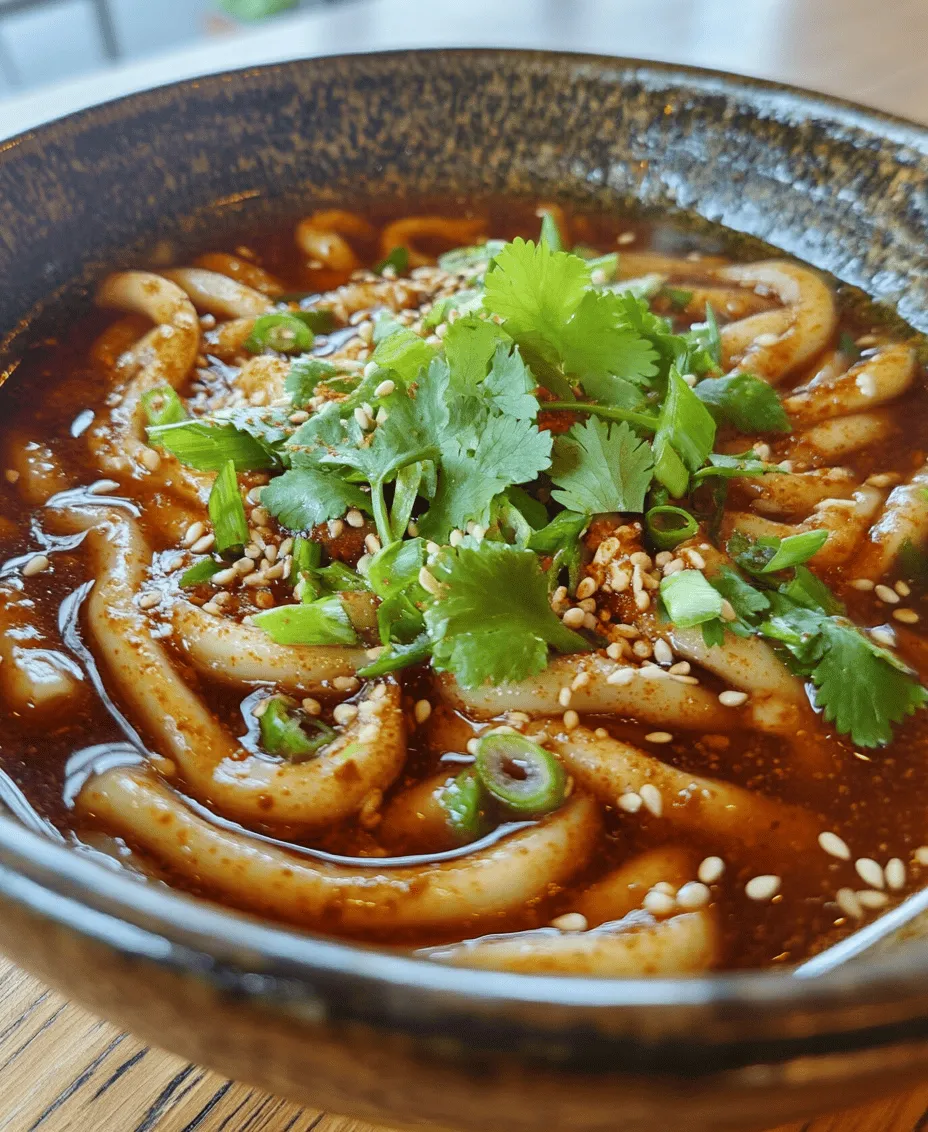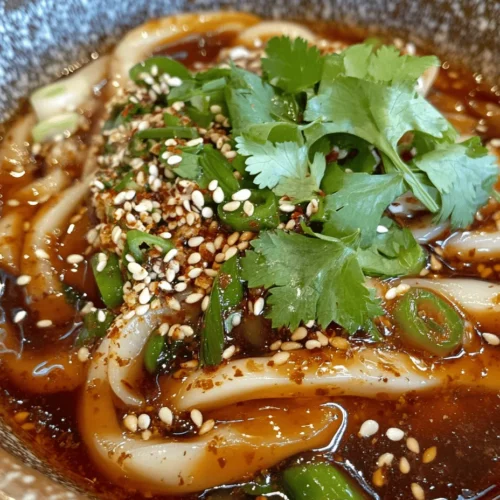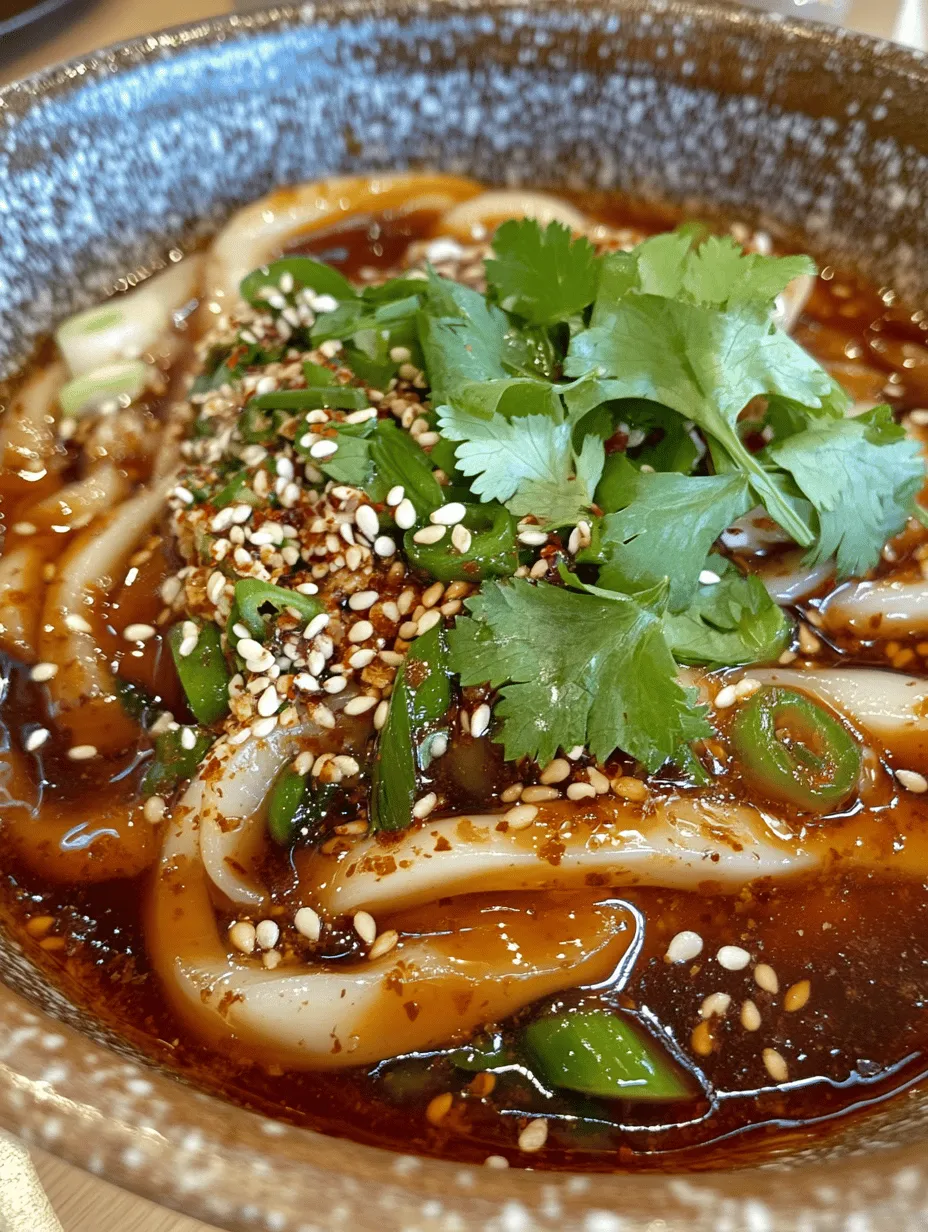Introduction
Udon noodles are a beloved staple of Asian cuisine, particularly renowned for their thick, chewy texture and versatility in a variety of dishes. Originating from Japan, these wheat-based noodles have captured hearts and appetites worldwide, often serving as the base for comforting soups, stir-fries, and salads. Their ability to absorb flavors makes them an ideal canvas for a range of sauces and ingredients, which is why they are perfect for quick and easy meals.
In today’s fast-paced world, the demand for quick meal solutions has risen significantly. Enter the 10-Minute Chili Oil Udon Noodles—a dish that perfectly embodies the essence of speed without compromising on flavor. This recipe is designed for those who crave a delicious, satisfying meal but don’t have hours to spend in the kitchen. Within just ten minutes, you can whip up a bowl of udon noodles infused with the rich, spicy notes of chili oil, creating a dish that is as delightful to the palate as it is simple to prepare.
Chili oil, a staple in many Asian kitchens, plays a pivotal role in enhancing the flavor profile of this dish. Its unique combination of heat, depth, and aromatic qualities transforms the udon noodles into a vibrant meal that excites the taste buds. This article aims to guide you through the process of making these delectable chili oil udon noodles, providing tips and insights along the way to ensure that your dish comes out perfect every time.
Understanding Udon Noodles
Udon noodles are thick, chewy noodles made from wheat flour, water, and salt. They can be enjoyed in various forms, whether served in a hot broth, tossed in a savory sauce, or stir-fried with an array of vegetables and proteins. Their origin can be traced back to Japan, where they have been a beloved part of the culinary landscape for centuries. The name “udon” is derived from the Japanese words “u” (to knead) and “don” (thick), aptly describing the texture of these delightful noodles.
Nutritional Benefits of Udon Noodles
Udon noodles are not just delicious; they also offer several nutritional benefits. They are a good source of carbohydrates, which provide energy, making them an excellent choice for a quick meal. While they are lower in protein compared to other noodle types, they can be easily complemented with proteins such as chicken, shrimp, or tofu to create a balanced dish. Additionally, udon noodles are typically low in fat and cholesterol-free, making them a heart-healthy option for those looking to maintain a balanced diet.
Different Types of Udon Noodles Available in the Market
When it comes to purchasing udon noodles, there are a few different types you might encounter. Fresh udon noodles are often found in the refrigerated section of Asian grocery stores and have a wonderfully soft texture that cooks quickly. Dried udon noodles, on the other hand, can be stored in your pantry and have a longer shelf life, though they may require a few extra minutes of cooking time. Instant udon noodles are another popular option, which are pre-cooked and can be ready in just a few minutes. Each type has its unique charm, and the choice ultimately depends on your preference and convenience.
Tips for Choosing the Right Udon Noodles for This Recipe
For the 10-Minute Chili Oil Udon Noodles, we recommend using fresh udon noodles if they are available. Their soft and chewy texture pairs beautifully with the spicy chili oil, ensuring a satisfying bite. However, if you opt for dried or instant noodles, be sure to follow the cooking instructions on the package for the best results. Whichever type you choose, make sure to select high-quality noodles for optimal flavor and texture.
The Allure of Chili Oil
Chili oil is a fragrant, spicy oil that serves as a flavor enhancer in many Asian dishes. Its significance in Asian cuisine cannot be overstated; it adds depth, warmth, and a delightful kick to everything from stir-fries to soups. The beauty of chili oil lies in its versatility—whether you prefer a milder flavor or a fiery heat, you can easily adjust the spice level to suit your taste.
Overview of the Ingredients Typically Used in Chili Oil
Chili oil is typically made from a base of vegetable oil infused with dried chili flakes, garlic, and other aromatics. Common ingredients include Sichuan peppercorns for an extra hint of numbing spice, ginger for warmth, and sesame seeds for nuttiness. The result is an oil that not only adds heat but also layers of flavor that can elevate any dish.
Benefits of Using Chili Oil
The benefits of incorporating chili oil into your cooking extend beyond flavor enhancement. Chili oil contains capsaicin, the compound responsible for the heat in chili peppers, which has been shown to have several health benefits, including boosting metabolism and reducing inflammation. Additionally, the infusion of garlic and other spices can provide antioxidant properties, making chili oil a flavorful way to add health benefits to your meals.
Comparison of Store-Bought vs. Homemade Chili Oil
While store-bought chili oil is convenient and readily available, making your own at home allows you to customize the heat level and flavor profile to your liking. A simple homemade chili oil recipe usually involves heating your choice of oil, such as vegetable or sesame oil, and adding dried chili flakes, garlic, and other aromatics. In just a few minutes, you can create a fresh and vibrant chili oil that will enhance your udon noodle dish. For those pressed for time, high-quality store-bought options can be just as effective, so don’t hesitate to explore various brands to find your favorite.
Ingredients Breakdown
To prepare your 10-Minute Chili Oil Udon Noodles, you will need a selection of flavorful ingredients that come together to create a deliciously satisfying dish. Below is a detailed description of each ingredient and its importance in the recipe.
Udon Noodles
– Cooking Tips and Alternatives: As mentioned earlier, fresh udon noodles are ideal for this recipe due to their soft texture. However, if fresh noodles are not available, you can use dried or instant noodles as alternatives. Be sure to adjust the cooking time according to the type of noodles you choose, ensuring they are cooked al dente for the best bite.
Chili Oil
– Types and Brands Recommended: Whether you choose to make your own chili oil or buy a store-bought version, opt for high-quality brands that use real ingredients without artificial additives. Look for chili oils that specify the type of chili used, as different varieties can offer distinct flavor profiles.
Soy Sauce
– Varieties and Their Flavor Notes: Soy sauce plays a crucial role in imparting umami depth to the dish. You can choose between light soy sauce, which is saltier and lighter in color, or dark soy sauce, which is richer and sweeter. For those looking to reduce sodium intake, low-sodium soy sauce is an excellent alternative.
Rice Vinegar
– Its Role in Balancing Flavors: Rice vinegar is essential for balancing the richness of the chili oil and soy sauce. It adds a subtle tang that enhances the overall flavor of the dish. Make sure to use a good quality rice vinegar to achieve the best results.
Sesame Oil
– Benefits and Flavor Profile: A drizzle of toasted sesame oil adds a nutty aroma and flavor that complements the other ingredients beautifully. Rich in antioxidants, sesame oil also contributes health benefits while enhancing the dish’s overall taste.
Green Onions
– How They Complement the Dish: Green onions, or scallions, add a fresh crunch and mild oniony flavor that brightens the dish. They can be used as a garnish or incorporated into the noodles for added texture.
Garlic and Ginger
– Their Health Benefits and Flavor Contributions: Both garlic and ginger are not only aromatic but also packed with health benefits. Garlic has been linked to improved immune function, while ginger is known for its anti-inflammatory properties. Their flavors work harmoniously to elevate the taste of the udon noodles.
Toasted Sesame Seeds
– Nutritional Value and Usage: Toasted sesame seeds provide a delightful crunch and additional nuttiness to the dish. They are rich in healthy fats, vitamins, and minerals, making them a nutritious topping. Sprinkle them generously over the finished dish for a textural contrast.
Optional Proteins
– Benefits of Shrimp, Tofu, or Edamame: For those looking to add protein to their meal, shrimp, tofu, or edamame are excellent options. Shrimp can be quickly sautéed and tossed into the noodles, while tofu can be pan-fried for a crispy texture. Edamame adds a pop of color and nutrition, making your udon noodles more satisfying.
Importance of Fresh Ingredients for Optimal Flavor and Nutrition
Ultimately, the key to achieving the best flavors in your 10-Minute Chili Oil Udon Noodles lies in using fresh, high-quality ingredients. Fresh vegetables and aromatics will significantly enhance the taste and nutritional value of your dish, making every bite a delightful experience. When you prioritize freshness, your quick meal will not only be convenient but also packed with flavor and health benefits.
With a clear understanding of udon noodles, the allure of chili oil, and the essential ingredients at hand, you’re now ready to embark on the journey of creating your own delicious 10-Minute Chili Oil Udon Noodles. Stay tuned for the next section, where we will delve into the step-by-step instructions to guide you through this quick and delightful culinary experience.

Step-by-Step Cooking Instructions
Cooking Udon Noodles
To achieve the perfect texture for your udon noodles, start by bringing a large pot of water to a rolling boil. Udon noodles typically require about 8-10 minutes to cook, depending on whether they are fresh or dried. If you are using dried noodles, check the package instructions for the exact cooking time.
Tip: Stir the noodles occasionally to prevent them from sticking together. Once cooked, drain the noodles and rinse them under cold water to stop the cooking process. This step also helps remove excess starch, ensuring a non-sticky texture that’s ideal for absorbing the sauce later.
Making the Sauce
While the noodles are cooking, it’s time to prepare the sauce. In a small bowl, mix soy sauce, rice vinegar, sesame oil, and chili oil. The key to a well-balanced sauce is in its components; you want the umami from the soy sauce, the tang from the vinegar, and the richness from the sesame oil to harmonize with the heat of the chili oil.
Tip: Taste the sauce as you mix. If you like it spicier, add more chili oil gradually until you reach your desired level of heat. For a touch of sweetness, consider adding a teaspoon of sugar or honey, which can help balance the flavors.
Sautéing Aromatics
In a large pan or wok, heat a tablespoon of vegetable oil over medium heat. Once hot, add minced garlic and ginger, sautéing them for about 30 seconds until fragrant. Be careful not to burn them, as burnt garlic can impart a bitter taste to your dish.
Tip: Keep stirring the aromatics. If you notice them starting to brown too quickly, lower the heat. You want them to be golden and fragrant but not burnt.
Combining Ingredients
Once the aromatics are ready, add the drained udon noodles directly into the pan. Pour the prepared sauce over the noodles and toss everything together gently. Use tongs or chopsticks to combine the ingredients thoroughly, ensuring that every strand of noodle is coated with the sauce.
Tip: If the noodles seem dry, add a splash of cooking water to help distribute the sauce evenly. This will also create a silkier texture and enhance the overall mouthfeel of the dish.
Adding Toppings
For a more nutritious and flavorful meal, consider adding protein and vegetables. Cooked chicken, shrimp, or tofu can elevate the dish, providing additional texture and taste. Simply toss your chosen protein into the pan after mixing the noodles and sauce.
Tip: For added crunch and flavor, top your dish with sliced green onions, sesame seeds, or even a sprinkle of crushed peanuts. These toppings not only enhance the visual appeal but also introduce different textures.
Serving Suggestions
When it comes to serving your chili oil udon noodles, presentation plays a key role. Use a large, shallow bowl to showcase the noodles, and arrange the toppings artfully on top. A drizzle of extra chili oil and a sprinkle of fresh herbs like cilantro or basil can add a vibrant finish.
Tip: Serve the dish immediately while it’s hot, accompanied by chopsticks and a small dish of extra chili oil on the side for those who may want to adjust the heat level.
Flavor Variations and Customizations
This 10-minute chili oil udon noodles recipe is highly versatile and can be customized to suit various dietary preferences and tastes.
– Personalizing the Dish: Feel free to swap the udon noodles for another noodle type, such as soba or rice noodles, depending on your preference or what you have on hand. Each type will impart a different flavor and texture to the dish.
– Dietary Restrictions: If you need a gluten-free option, choose gluten-free udon noodles or use rice noodles. For a vegan dish, ensure that the soy sauce is free of animal products and omit any animal-based proteins.
– Spiciness Levels: Adjust the amount of chili oil based on your heat tolerance. Start with a small drizzle and increase according to your taste. You can also mix in red pepper flakes or fresh chopped chilies for additional heat.
– Additional Toppings: Consider adding stir-fried vegetables such as bell peppers, bok choy, or snap peas for a colorful and nutritious boost. Fresh herbs like cilantro or mint can brighten the dish, while a squeeze of lime can add a refreshing zing.
Nutritional Information
A serving of 10-minute chili oil udon noodles (without additional protein) contains approximately:
– Calories: 400
– Protein: 10g
– Carbohydrates: 60g
– Fat: 15g
– Fiber: 2g
Health Benefits: Udon noodles provide a good source of carbohydrates, which are essential for energy, while the garlic and ginger in the dish offer anti-inflammatory properties. The addition of vegetables and proteins can enhance the nutritional profile, providing vitamins, minerals, and healthy fats.
Making it Healthier: To reduce calories, consider using less oil and opting for low-sodium soy sauce. Incorporating more vegetables can boost fiber content, making the dish more filling without adding excessive calories.
Pairing Suggestions
To round out your meal, consider these side dishes that pair well with chili oil udon noodles:
– Side Dishes: A simple cucumber salad tossed in rice vinegar or a light miso soup can serve as refreshing complements. These dishes offer contrast and balance to the richness of the udon noodles.
– Beverage Pairings: For drinks, a chilled green tea can cleanse the palate and enhance the meal experience. If you’re in the mood for something stronger, a light, crisp white wine such as Sauvignon Blanc can work well, while a lightly flavored craft beer can also be a delightful pairing.
– Creating a Complete Meal: You might also want to serve a small appetizer like edamame or gyoza to create a multi-course dining experience. This not only adds variety but also makes for a more satisfying meal.
Cultural Insights
Udon noodles have a rich history in Japanese cuisine, having been enjoyed for centuries. Originating in China, udon made its way to Japan, where it became a staple in various regional dishes. The texture and thickness of udon noodles set them apart, making them perfect for hearty broths or stir-fries.
Regional Variations: Depending on the region in Japan, udon dishes can differ dramatically. For instance, in Kagawa, you’ll find the famous sanuki udon, known for its chewy texture. Meanwhile, in Osaka, udon is often served in a dashi broth with various toppings.
Chili oil, while not traditionally Japanese, has gained popularity in modern cuisine, especially with the rise of fusion dishes. Its bold flavor complements the mildness of udon noodles, leading to its incorporation into various recipes.
Conclusion
The 10-minute chili oil udon noodles embody simplicity and deliciousness, making it a perfect dish for quick weeknight dinners or leisurely weekend meals. This recipe not only provides a delightful culinary experience but also invites you to explore your creativity in the kitchen.
Don’t hesitate to experiment with different ingredients and flavors to make this dish uniquely yours. In today’s fast-paced lifestyle, quick meals like these play a crucial role in helping us enjoy flavorful and satisfying food at home without spending hours in the kitchen. Embrace the joy of cooking and enjoy the process of making this delightful dish!



